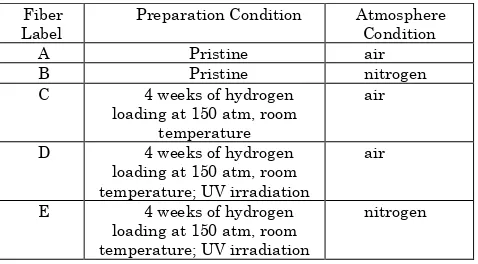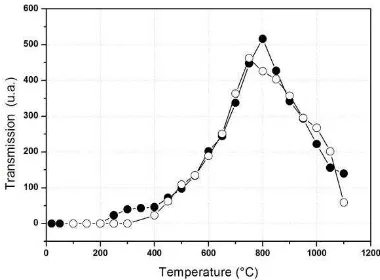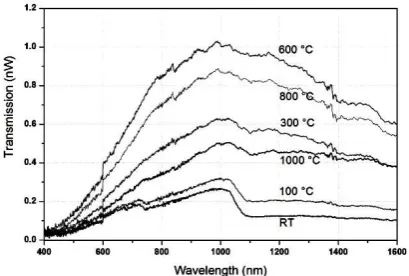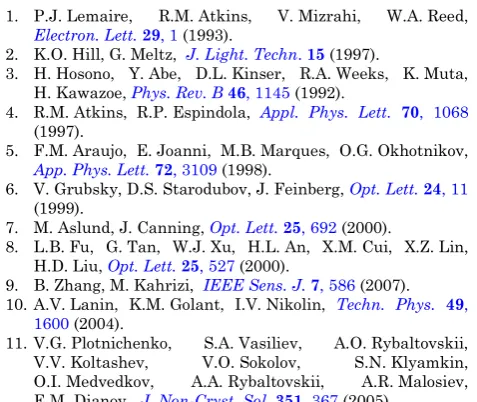JOURNAL OF NANO- AND ELECTRONIC PHYSICS Р А А - А Р
Vol. 9 No 1, 01027(4pp) (2017) Том 9 № 1, 01027(4cc) (2017)
2077-6772/2017/9(1)01027(4) 01027-1 2017 Sumy State University
Hydroxyl Properties of Hydrogenated Germanosilicate Optical Fiber Due to Thermal Treatment and Ultraviolet Irradiation
H. Kuswanto1, A. Hermanto2, F. Goutaland3, A. Boukenter3, Y. Ouerdane3
1 Physics Education Department, Universitas Negeri Yogyakarta, Yogyakarta, Indonesia
2 Physics Department, Universitas Gadjah Mada, Yogyakarta, Indonesia
3 Laboratoire Traitement du Signal et Instrumentation UMR CNRS 5516, Université Jean Monnet de Saint
Etienne, France
(Received 10 October 2016; published online 20 February 2017)
The aim of the research was to examine the formation and destruction of the hydroxyl in optical fibers by comparing the ambient atmosphere, air, and nitrogen during thermal treatment from room temperature up to 1100 °C. It has been shown that during the heat treatment, molecular hydrogen dissolved in the fiber plays no role in the formation of OH while under UV irradiation the formation is dependent on the presence of dissolved hydrogen. The heat treatment preferentially leads to the formation of Si-OH, while during irradiation it assists the formation of both Ge-OH and Si-OH.
Keywords: Hydroxyl, Ultraviolet, Thermal, Optical Fiber, Nitrogen.
DOI: 10.21272/jnep.9(1).01027 PACS numbers: 42.81.Dp, 61.80.Ba, 85.40.Ry, 68.60.Dv
1. INTRODUCTION
Hydrogen loading is one of the most effective methods for enhancing the photosensitivity [1-3] of optical fibers, i.e., an induced permanent change in the refractive index by UV exposure to a proper laser light [2, 4-6]. In non-hydrogen-loaded fibers, it is believed that photosensitivity is related to the absorption band at 5.1 eV due to a germanium oxygen deficient center (GODC), which has two types of defects: a neutral oxygen vacancy (NOV) peaking at 5.06 eV and a germanium lone pair center (GLPC) peaking at 5.14 eV [3, 7-8]. This process attracts much attention especially for the manufacture of the fiber Bragg gratings for use in such diverse applications as WDM devices, external cavity semiconductor laser, and strain sensor [2].
Gratings written in hydrogen-loaded fibers are less stable at low temperature than those written in unloaded ones [2, 4-6]; however, post-exposure to a uniform UV-beam could improve the index modulation and thermal stability of gratings written in hydrogen- loaded fibers [3, 7-8]. It has been reported that various hydrogen-related centers such as Si-OH, OH, Ge-H2, Ge-H, water, and germyl radicals are generated by UV-irradiation, heating, or -ray irradiation in hydrogen-loaded germanium doped silica fibers [9-11]. To investigate hydrogen-related defects, experiments with various spectroscopy types such as infrared [4, 12], Raman [5, 13-14], luminescence [6, 15] and ESR spectroscopy [7, 17-18] have been carried out on hydrogen-loaded performs or fibers. However, the mechanisms underlying the chemical reactions have not yet been fully clarified. Therefore, it is important to elucidate the nature of these defects in the presence of hydrogen due to annealing at elevated temperature and laser irradiation.
In the present study, we have compared the dynamics of hydroxyl in non-hydrogen- and hydrogen- loaded fibers due to thermal treatment. The results show that the thermal treatment in the air atmosphere
contributes to the hydroxyl formation. We also studied the thermal properties of UV-irradiated induced hydroxyl in hydrogen-loaded fibers.
2. EXPERIMENTAL SET-UP
The fibers examined in this study are the telecommunication standard germanosilicate Corning fibers (identified as SMF-28). The information provided by the manufacturer indicates that the core diameter is 8.3 m, the difference in refractive index is 4.5 10– 3, and the germanium concentration is 4.8 %. This fiber type is used for telecommunications applications using the singlemode light transmission fiber since it is of 1.3 microns and 1.55 microns in diameter. The polymer jacketing was stripped from the fibers by using a chemical stripper.
The preparation of the fiber to investigate the chemical reaction due to the thermal treatment is shown in Table 1. One of the non-hydrogen-loaded fibers (labeled fiber A) was heated in air and another (labeled fiber B) was heated in nitrogen atmosphere. Hydrogen-loaded fibers (labeled fiber C) were pressured in hydrogen (180 atm at room temperature) for periods of four weeks.
Table 1 –List of fiber types, preparation conditions and atmosphere conditions of the oven
Fiber Label
Preparation Condition Atmosphere Condition
A Pristine air
B Pristine nitrogen
C 4 weeks of hydrogen loading at 150 atm, room
temperature
air
D 4 weeks of hydrogen loading at 150 atm, room temperature; UV irradiation
air
E 4 weeks of hydrogen loading at 150 atm, room temperature; UV irradiation
H. KUSWANTO, A. HERMANTO, F. GOUTALAND, ET AL. J.NANO-ELECTRON.PHYS. 9, 01027 (2017)
01027-2 This study also examined the creation and destruction of hydroxyl induced by ultraviolet radiation on the hydrogenated fiber (fiber D). The ultraviolet laser beams of Argon with doubled frequency at 244 nm (P = 60 mW) were focused onto the core of the fiber with a spherical lens (f = 150 mm). During irradiation, the fiber was uniformly driven using an electric motor. With this arrangement, it could be irradiated up to 80 cm in length. After irradiation, the fiber was returned to its original position to register the spectrum. One fiber D was heated in air and another was heated in nitrogen atmosphere (to become fiber E).
Any of the fiber tested has been around 5 m in length. The mechanical sheath of the fiber was stripped chemically on its entire length. To avoid direct contact between the fiber and the ceramics oven, we used a quartz tube as place of the fiber. The fiber was placed in a quartz tube 65 mm in diameter and 500 mm long. The fiber was turned within the tube. In order to follow spectral changes, the two ends of the fiber were each given an allowance of about 30 cm outside the tube. Then the tube was placed inside the programmable oven. Both ends of the fiber were kept at the outside of the oven for measuring the spectra in situ.
For measuring the attenuation, the white source (ANDO AQ-6315B) was injected to one end of the fiber and the spectra were recorded by optical spectrum analyzer (ANDO AQ-6315A) at the other end. The oven was adjusted for temperature increase of 15 °C/min. The spectra were recorded 15 minutes after the chosen temperature was achieved in every 50 °C interval of the increasing temperature. We examined the formation and destruction of the hydroxyl on the fiber by comparison of the ambient atmosphere, air, and nitrogen during the thermal treatment from room temperature up to 1100 °C.
3. RESULTS AND DISCUSSION
3.1 Thermal Treatment
The transmission spectrum in Figure 1 shows an appearance of a band at 1390 nm because SiOH in the hydrogenated fiber was annealed at 500 °C. This band was not observed after treatment at 200 °C unless the decrease of the band at 1240 nm was due to molecular hydrogen. Note that in this experiment, a portion of the fiber remains outside of the oven, so a remaining hydrogen band after treatment is due to that part.
Fig. 1– Spectrum of the hydrogenated fiber transmission: (a) initially, (b) after annealing to 200 °C, and (c) after annealing at 500 °C for one hour respectively
Figure 2 shows the change in transmission due to heat treatment on virgin fiber in the air atmosphere. It could be noted that its transmissions generally increase with temperature growth to 500 °C and then decrease after that.
We could also note the appearance of the absorption band around 1390 nm from the temperature of up to 400 °C. Figure 3 shows the evolution of this band during treatment. Due to changes of the transmission, the peak height which corresponds to the generated hydroxyl concentration is obtained by the difference between the peak and the bottom of that for each temperature. The concentration of hydroxyl is to augment at the temperature of around 750 °C and then to decrease as a result of the growth of temperature.
Fig. 2– Evolution of the transmission of the SMF-28 blank heat treatment in the atmosphere of air
Figure 3 also shows the evolution of hydroxyl of hydrogenated fiber. Above the temperature of 450 °C the evolution of this hydroxyl looks alike in the same way. However, below the temperature of 450 °C, these developments are different. In the case of hydrogenated fiber, the absorption band appeared from the temperature of 250 °C. To ensure these results, we replaced it with other fibers (hydrogenated and pristine) and replaced the air with nitrogen gas.
Fig. 3 –Evolution of hydroxyl around 1390 nm thermal treatment in the air of the SMF 28: blank (open circle) and hydrogenated (full circle)
HYDROXYL PROPERTIES OF HYDROGEN … J.NANO-ELECTRON.PHYS. 9, 01027 (2017)
01027-3 Fig. 4– Evolution of the transmission in the SMF-28 fiber with heat treatment in nitrogen. The hydroxyl peak around 1390 nm does not appear in these conditions
genated fiber at temperature 250 °C could not be correlated to the reaction of hydrogen from the fiber. We compared the extent of hydroxyl at the temperature and at completed room temperature, i.e., after cooling of the completed temperature, and we observed the overall decrease of the transmission; when measured at room temperature, however, the amplitude of the hydroxyl generated was constant. The change in transmission could be explained by the change of axial stress within the fiber due to thermal treatment.
The occurrence of hydroxyl in germanosilicate fiber resulting from a treatment on a fiber with a length of 300 m at the temperature of 250-500 °C has been explained [19]. What is proposed is that the hydrogen comes from the mechanical sheath material, i.e., a silicone resin. This hydrogen is reacting with the normal networks of the fiber or their precursor such as GeE’, NBOH, or radical peroxide. The products of this reaction depend on the temperature treatment. Note that in our experiment, mechanical cladding of the fiber has been stripped; therefore, we do not think that the appearance of hydroxyl is due to the reaction of hydrogen with the normal fiber networks or their precursor such as GeE’, NBOH, or radical peroxide. This proposal is supported by the experiment in the atmosphere of nitrogen; we could not observe the appearance of the hydroxyl as shown in Figure 3.
With regard to the creation of hydroxyl, it has been proposed that a reaction could happen with H2O2 molecules in the interior of the glass to create H2O [20]. H2O which is drawn reacts with the glass to form a hydroxyl-free compound and to form a hydride. So it is reasonable to propose a two-stage process where the water molecules formed come from the gases and then the hydroxyls are formed by the reaction of these compounds with a bond of the glass, i.e.:
2H2 + O2 2H2O (1)
2H2O + 2 Si-O-Si 4 SiOH (2)
Our results are similar to the results of a study of the commercial silica glass exposed to water vapor at 1000 °C at one atmosphere of pressure [22]. It was found that in the glass initially having very low hydroxyl concentration, the hydroxyl concentration increased sharply. However, the Suprasil lens glass, originally having more than 1200 ppm of hydroxyl,
decreased in its hydroxyl concentration. Finally, all the glass reached the same concentration of hydroxyl. After this condition of equilibration, the hydroxyl concentration of all the lenses used was reduced gently. These phenomena were due to the relaxation attributed to volume networks. Because the hydroxyl concentration of each sample approached the same value, then the viscosity of each sample would also approach the same value. So they went on to relax similarly. The hydroxyl was to decrease at the higher temperature of 800 °C due to the faulty GeH. So the rises of heat treatment temperature would return the condition of the structure to the initial condition.
3.2 Ultraviolet Irradiation
Figure 5 shows the transmission spectra of the hydrogenated fiber irradiated at 244 nm in the region of 1200-1600 nm. Before irradiation, it could be noted that the peak of hydrogen transmission at 1240 nm was due to the hydrogen. After irradiation, one could observe a peak lying around 1400 nm due to a hydroxyl group. We have succeeded in the decomposition of the transmission band due to the presence of hydroxyls into two Gaussian bands situated at 1390 and 1410 nm. Changes in the concentration of these species in the number of passages function to produce the irradiation energy as shown in Figure 6. The concentration of the hydroxyl group monotonously shows the number of irradiation passages, and then it decreases at the sixth pass.
Fig. 5 – Hydroxyl Evolution for the Hydrogenated Fiber for Irradiation at 244 nm
Fig. 6 –Evolution of the hydroxyl component of the hydrogenated fiber during irradiation at 244 nm to the number of irradiation passages
H. KUSWANTO, A. HERMANTO, F. GOUTALAND, ET AL. J.NANO-ELECTRON.PHYS. 9, 01027 (2017)
01027-4 component up to 1390 nm shows monotonously until the last passage; however, in the case of the peak at 1410 nm, it is believed to show monotonously until the fifth pass and then declines in the sixth pass. Note that the hydroxyl creation due to the heat treatment appears at the peak around 1390 nm.
Fig. 7 – Hydroxyl Evolution induced by irradiation of the hydrogenated fiber. Heat treatment in the air (a) and (b) nitrogen atmosphere respectively
Figure 7 shows that the hydroxyl properties induced by irradiation of hydrogenated fiber are temperature-dependent ones in the atmosphere of air and nitrogen. The hydroxyl concentration increases slightly when the fiber is treated in the respective atmosphere of air and nitrogen. After the temperature rises, the hydroxyl concentration is reduced with
temperature growth. It could be seen that one could divide the thermal treatment into three areas of treatment temperature: (a) from room temperature to 200 °C, (b) from 200 to 800°C and then (c) to that slightly over 800 °C.
In the region below the temperature of 200 °C, the increase in hydroxyl concentration could be seen. The hydroxyl evolution of the hydrogenated fiber is in these annealing temperatures. We have seen that the ultraviolet irradiation on the hydrogenated fiber produces not only the OH group but also other species as has been discussed in a previous paragraph. Therefore, these species continuously react in heat treatment.
It also occurs in the nitrogen atmosphere. After reaching the equilibrium condition, hydroxyl has the following property, i.e., its concentration decreases with the heat treatment above 800 °C.
4. CONCLUSIONS
It has been shown that during heat treatment, molecular hydrogen dissolved in a fiber plays no role in the formation of OH, while under UV irradiation the formation is dependent on the presence of dissolved hydrogen. The heat treatment preferentially leads to the formation of Si-OH while during irradiation it assists the formation of both Ge-OH and Si-OH.
REFERENCES
1. P.J. Lemaire, R.M. Atkins, V. Mizrahi, W.A. Reed,
Electron. Lett.29, 1 (1993).
2. K.O. Hill, G. Meltz, J. Light. Techn. 15 (1997).
3. H. Hosono, Y. Abe, D.L. Kinser, R.A. Weeks, K. Muta, H. Kawazoe, Phys. Rev. B46, 1145 (1992).
4. R.M. Atkins, R.P. Espindola, Appl. Phys. Lett. 70, 1068
(1997).
5. F.M. Araujo, E. Joanni, M.B. Marques, O.G. Okhotnikov,
App. Phys. Lett.72, 3109 (1998).
6. V. Grubsky, D.S. Starodubov, J. Feinberg, Opt. Lett.24, 11
(1999).
7. M. Aslund, J. Canning, Opt. Lett.25, 692 (2000).
8. L.B. Fu, G. Tan, W.J. Xu, H.L. An, X.M. Cui, X.Z. Lin, H.D. Liu, Opt. Lett.25, 527 (2000).
9. B. Zhang, M. Kahrizi, IEEE Sens. J.7, 586 (2007). 10.A.V. Lanin, K.M. Golant, I.V. Nikolin, Techn. Phys. 49,
1600 (2004).
11.V.G. Plotnichenko, S.A. Vasiliev, A.O. Rybaltovskii, V.V. Koltashev, V.O. Sokolov, S.N. Klyamkin, O.I. Medvedkov, A.A. Rybaltovskii, A.R. Malosiev, E.M. Dianov, J. Non-Cryst. Sol.351, 367 (2005).
12.N. Troy, W. Christopher, Smelser, D.M. Krol, Opt. Mat. Exp.2, 1663 (2012).
13.A.O. Rybaltovskii, V.V. Koltashev, O.I. Medvedkov, A.A. Rybaltovskii, V.O. Sokolov, S.N. Klyamkin, V.G. Plotnichenko, E.M. Dianov, Quant. Electr. 38, 1147 (2008).
14.K. Awazu, K.I. Muta, H. Kawazoe, J. Appl. Phys.74, 237
(1993).
15.P. Cordier, C. Dalle, C. Depecker, P. Bernage, M. Douay, P. Niay, J.F. Bayon, L. Dong, J. Non-Cryst. Sol.224, 277
(1998).
16.B.I. Green, D.M. Krol, S.G. Kosinski, P.J. Lemaire, P.N. Saeta, J. Non-Cryst. Sol.180, 80 (1994).
17.T. Mizunami, M. Yamashiro, S. Gupta, T. Shimomura,
Opt. Com.162, 85 (1999).
18.P. Holmberg, F. Laurell, M. Fokine, Opt. Expr. 23, 27520
(2015).
19.M. Nakahara, Y. Ohmori, H. Itoh, M. Shimizu, N. Inagaki,
J. Light. Tech.4, 127 (1986).



